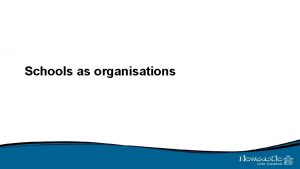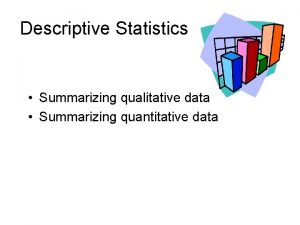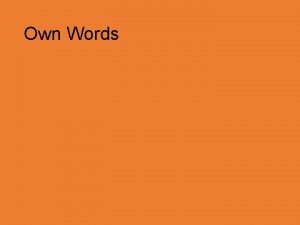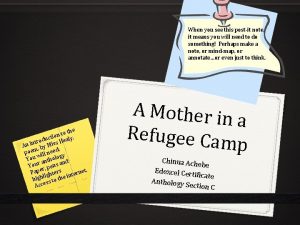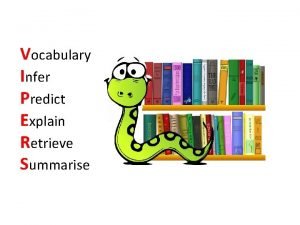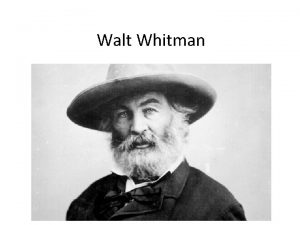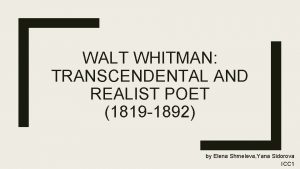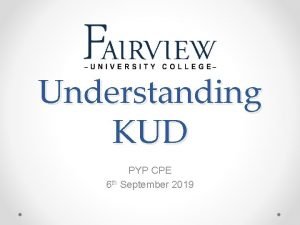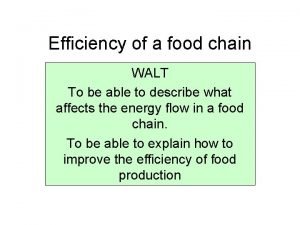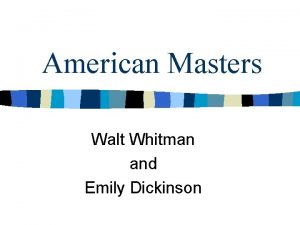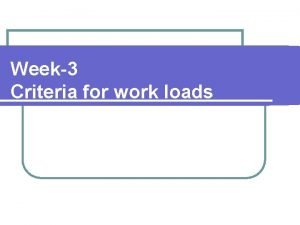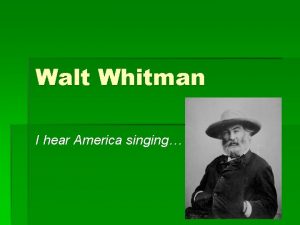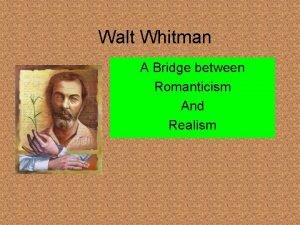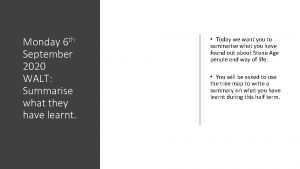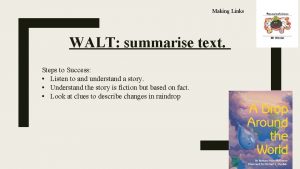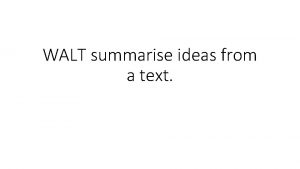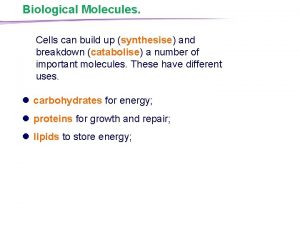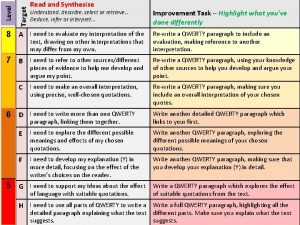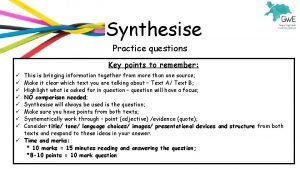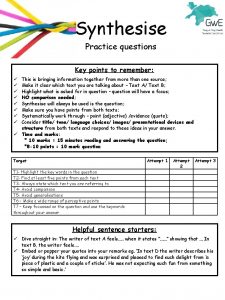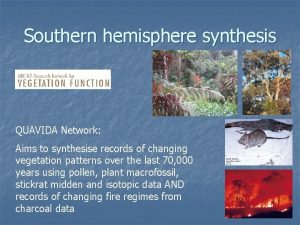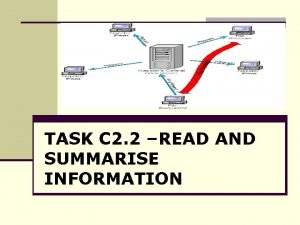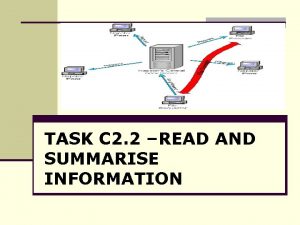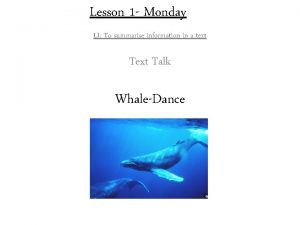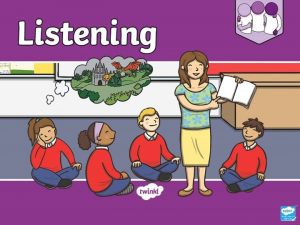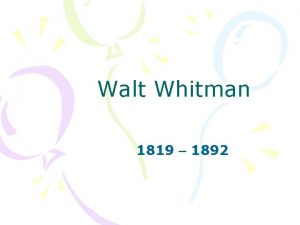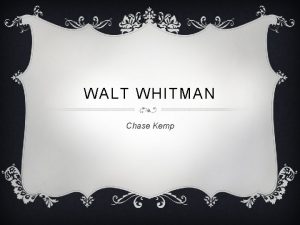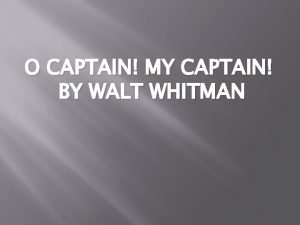School WALT synthesise and summarise information What are
























- Slides: 24

School WALT: synthesise and summarise information What are the differences between school in the 19 th century and now?

QUESTION MARKS MINS Read the questions and annotate source 0 10 Question 1 – True or False 4 5 Question 2 - Select and Synthesise q Source A – 3 PEE paragraphs q Comparative Connective: However; Whereas; In contrast; Similarly; q Source B – 3 PEE paragraphs q Comparative Overview 8 10 -12 Question 3 – Language Analysis 12 10 -15 16 15 -20 q 4 Technique, Evidence, Effect paragraphs q word classes and phrases q paragraphs on language features q paragraphs on sentence forms Question 4 – Compare Writers’ Ideas and Perspectives q. Overview comparative statement about theme in sources – identify text type/content/tone/purpose/narrative mode of each source q. Source A - Point q. Evidence q. Technique – word classes and phrases, language features and techniques, sentence forms and structure q. Explanation q. Source B - Comparative/Contrastive Point: On the other hand, Source B… q. Evidence q. Technique – word classes and phrases, language features and techniques, sentence forms and structure q. Explanation ESSENTIALLY, IT’S 6 PETER PARAGRAPHS – 3 PETER PARAGRAPHS FOR EACH SOURCE




QUESTION 2: AO 1: Identify, Interpret, Select and Synthesise Level 4 Perceptive, detailed 7 -8 marks Level 3 Clear, relevant 5 -6 marks Level 2 Some, attempts 3 -4 marks Level 1 Simple, limited Skill Descriptors Shows a detailed understanding of differences between the texts Offers perceptive interpretation of both texts Synthesises evidence between texts Selects a range of judicious quotations from both texts Shows a clear understanding of differences between the texts Begins to interpret both texts Demonstrates clear connections between texts Selects relevant quotations/references from both texts to support response Identifies some differences between the texts Attempts some inference from one/both texts Attempts to link evidence between texts Selects some quotations/references; not always supporting (from one/both texts) Shows simple awareness of difference(s) Offers paraphrase rather than inference Makes simple or no links between texts Simple reference or textual details from one/both texts 1 -2 marks Level 0 No marks Candidates in this band will not have offered any differences Nothing to reward

Level? Level 4 Perceptive, detailed 7 -8 marks Level 3 Clear, relevant 5 -6 marks Level 2 Some, attempts 3 -4 marks Level 1 Simple, limited 1 -2 marks Level 0 No marks The boys at the ragged school are naughty. One of them swears at the teacher and runs away from school. It says he ‘rushed from the school’ which shows he ran away. In the other school they are much better and get on with their work better. They don’t swear at the teacher like the other boy did.

Level? Level 4 Perceptive, detailed 7 -8 marks Level 3 Clear, relevant 5 -6 marks Level 2 Some, attempts 3 -4 marks Level 1 Simple, limited 1 -2 marks Level 0 No marks The students at the primary school are better behaved than the students in the ragged school. The students at the primary school say ‘Hello’ to the visitor when they see him which shows they are polite and friendly. In the other school they aren’t so polite to visitors and they fight each other instead ‘They fought like furies’. This shows that they were not so well -behaved as modern children.

Level? Level 4 Perceptive, detailed 7 -8 marks Level 3 Clear, relevant 5 -6 marks Level 2 Some, attempts 3 -4 marks Level 1 Simple, limited 1 -2 marks Level 0 No marks The students at the primary school behave very well and work hard. The Inspector notices how ‘Each child we passed said ‘Hello, ’’ showing their politeness and good manners whereas the students in the ragged school are wilder and noisier. They are more likely to swear at the teacher and run away, as it states ‘he swore most horribly, and rushed from the school. ’ This indicates that in the primary school the students’ behaviour is carefully controlled by the teachers, whereas in the ragged school the teacher is struggling to cope with the students’ rough behaviour.

Level? Level 4 Perceptive, detailed 7 -8 marks Level 3 Clear, relevant 5 -6 marks Level 2 Some, attempts 3 -4 marks Level 1 Simple, limited 1 -2 marks Level 0 No marks The primary school pupils behave respectfully and enthusiastically, as shown in the cheerful greeting each child offers, saying ‘‘Hello, ’ brightly’ to the Inspector. The students behave politely to both teachers and visitors, unlike the students in the ragged school who appear to resent the authority of their teacher and behave violently towards him. One of the boys ‘swore most horribly and rushed from the school, ’ demonstrating his rudeness and disregard for the school rules. The diligent behaviour of the primary pupils is a result of the discipline and high expectations of their teachers, whereas the unruly behaviour in the ragged school demonstrates a lack of respect for the teacher, who is a different social class to them and with whom they are ‘at war. ’


QUESTION 3: AO 2 – Language Analysis Level Skill Descriptors This question assesses Language ie: Words / Phrases / Language Features / Language Techniques / Sentence Forms Level 4 Detailed, perceptive 10 -12 marks Level 3 Clear, relevant 7 -9 marks Level 2 Some, attempts 4 -6 marks Level 1 Simple, limited 1 -3 marks Level 0 No marks Shows detailed and perceptive understanding of language: • Analyses the effects of the writer’s choices of language • Selects a judicious range of textual detail • Makes sophisticated and accurate use of subject terminology Shows clear understanding of language: • Explains clearly the effects of the writer’s choices of language • Selects a range of relevant textual detail • Makes clear and accurate use of subject terminology Shows detailed and perceptive understanding of language: • Analyses the effects of the writer’s choices of language • Selects a judicious range of textual detail • Makes sophisticated and accurate use of subject terminology Shows simple awareness of language: • Offers simple comment on the effect of language • Selects simple references or textual details • Makes simple use of subject terminology, not always appropriately No ideas offered about differences Nothing to reward

Level? Level 4 Detailed, perceptive 10 -12 marks Level 3 Clear, relevant 7 -9 marks Level 2 Some, attempts 4 -6 marks Level 1 Simple, limited 1 -3 marks Level 0 No marks The writer describes Sister Brendan using words like ‘fluttering’ to show she goes down the corridors. He also says that she is chatting away, which shows that she is talking a lot. He describes what she looks like so we can imagine her better. He says she is ‘like a small hungry blackbird, ’ which is a simile that compares her to a bird saying she is like a blackbird.

Level? Level 4 Detailed, perceptive 10 -12 marks Level 3 Clear, relevant 7 -9 marks Level 2 Some, attempts 4 -6 marks Level 1 Simple, limited 1 -3 marks Level 0 No marks The writer uses lots of verbs to describe Sister Brendan, such as ‘fluttering’ and ‘chattering. ’ The word ‘fluttering’ makes me think of something flapping, so maybe she has got clothes on which are flapping and floating around. The word ‘chattering’ creates the impression that she is talking all the time and is very cheerful and friendly. The writer uses a simile to compare her to a ‘hungry blackbird’ which makes it sound like she is lively and hops around.

Level? Level 4 Detailed, perceptive 10 -12 marks Level 3 Clear, relevant 7 -9 marks Level 2 Some, attempts 4 -6 marks Level 1 Simple, limited 1 -3 marks Level 0 No marks Sister Brendan is described as someone who is ‘fluttering along the corridors’ as if she were quick and light on her feet, a bit like a bird, which links back to the description of her as a ‘blackbird. ’ She is also described as ‘chattering and chuckling’ which gives us an idea of how she is nattering away continuously to the Inspector. The alliteration of these words suggests the excited sounds of her chirping, like a baby bird, which creates the impression that Sister Brendan is talking non-stop to impress the Inspector.

Level? Level 4 Detailed, perceptive 10 -12 marks Level 3 Clear, relevant 7 -9 marks Level 2 Some, attempts 4 -6 marks Level 1 Simple, limited 1 -3 marks Level 0 No marks The writer describes her as an enthusiastic, excitable guide ‘fluttering along the corridors, ’ suggesting the flapping, hopping movement of a bird. This bird-like effect links to the metaphor of the ‘hungry blackbird out for the early worm’ creating the image of a fierce-minded, shrewd head teacher, who despite her small size, has a keen appetite for the ‘worm’ – the inspector. The string of short or single syllable words - ‘sharp little beak of a nose’ and ‘tiny, dark, darting eyes’ - suggests a constant, restless movement as she surveys the school. The assonance in ‘sharp’, ‘dark’ and ‘darting’ hints at something more aggressive about Sister Brendan, creating almost a sinister figure, although this is contrasted with her cheerful ‘chattering and chuckling, ’ implying the writer isn’t very sure about his formidable host.


QUESTION 4: AO 3 - Compare writers’ ideas and perspectives Level Skill Descriptors Compare writers’ ideas and perspectives, as well as how these are conveyed, across two or more texts Level 4 Detailed, perceptive 13 -16 marks Level 3 Clear, relevant 9 -12 marks Level 2 Some, attempts 5 -8 marks Level 1 Simple, limited 1 -4 marks Level 0 No marks Shows a detailed understanding of the differences between the ideas and perspectives Compares ideas and perspectives in a perceptive way Analyses how methods are used to convey ideas and perspectives Selects range of judicious quotations from both texts Shows a clear understanding of differences between the ideas and perspectives Compares ideas and perspectives in a clear and relevant way Explains clearly how methods are used to convey ideas and perspectives Selects relevant quotations to support from both texts Identifies some differences between the ideas and perspectives Attempts to compare ideas and perspectives Some comment on how methods are used to convey ideas and perspectives Selects some quotations/references, not always supporting (from one or both texts) Simple awareness of different ideas and/or perspectives Simple cross reference of ideas and/or perspectives Simple identification of how differences are conveyed Simple references or textual details from one or both texts No ideas offered about differences Nothing to reward

Level? Level 4 Detailed, perceptive 13 -16 marks Level 3 Clear, relevant 9 -12 marks Level 2 Some, attempts 5 -8 marks Level 1 Simple, limited 1 -4 marks Level 0 No marks The attitude to the school in Source A is that it is good and the children are learning a lot. I know this because the writer describes all the things the children have made, like ‘poems, posters, pictures. ’ In Source B the school is not so good and the children do not learn much because they are fighting and throwing stones. The writer in Source A shows that he thinks the school is good because the children are working all the time, but the other writer uses words like ‘boxing most viciously’ to show he thinks the students shouldn’t be fighting in school.

Level? Level 4 Detailed, perceptive 13 -16 marks Level 3 Clear, relevant 9 -12 marks Level 2 Some, attempts 5 -8 marks Level 1 Simple, limited 1 -4 marks Level 0 No marks The writer’s attitude to the school in the first source is very positive. He thinks the school does a good job teaching the children. The method he uses to show this is listing: ‘Children’s painting and poems, posters, pictures and book jackets. ’ This shows all the lovely different things the children have done at school. The other writer tries to have a positive attitude to his school, but it is harder for him because the children are not so well-behaved and willing to learn as in the primary school. He describes the girls fighting by using the word ‘viciously’ which is an adverb and shows that he is surprised by how violent they are, but he carries on teaching no matter how hard it is.

The writer of Source A is very impressed by the children he visits Level? whereas the writer of Source B is frustrated by the students and finds his job at the school much more challenging. The writer in Level Source A describes how the pupils work hard using a list: Level 4 ‘reading, writing, discussing, solving problems’ to show the Detailed, perceptive 13 -16 marks variety of educational activities available and he compares the Level 3 school to ‘a hive of activity’ suggesting an admiration for the Clear, relevant 9 -12 marks children working busily and in a focused way, like bees. On the Level 2 other hand, in Source B, the writer’s negative attitude is shown Some, attempts by phrases such as ‘boxing most viciously’ where the adverb 5 -8 marks ‘viciously’ shows how shocked he is by how violently the girls are Level 1 Simple, limited fighting, especially in a school environment. This reinforces the 1 -4 marks Level 0 writer’s committed attitude to the school as despite the No marks challenges he keeps coming back the next day to try again.

Level? Level 4 Detailed, perceptive 13 -16 marks Level 3 Clear, relevant 9 -12 marks Level 2 Some, attempts 5 -8 marks Level 1 Simple, limited 1 -4 marks Level 0 No marks Structurally, both texts open with a view of the surrounding area: ‘derelict’ in Source A and ‘squalid’ in Source B, thereby establishing the challenges facing the schools from the outset, but giving Phinn the opportunity later to contrast and highlight the achievements of the school despite the disadvantages. However, Phinn’s perspective is that of a visiting observer, whereas the writer of Source B is daily risking injury to teach students whom he feels are metaphorically ‘at war’ with him. The adverbs ‘viciously’ and ‘fearfully’ extend the imagery of school as a war zone. In contrast, Phinn’s tone is admiring in his comparison of the school to a ‘hive of activity’ reinforcing his view of the industrious and harmonious community of ‘busy bodies’, suggesting he sees the school as inspiring and hopeful, unlike the master who uses a short, bleak sentence to express his pessimistic view of the future: ‘It is a forlorn hope. ’


Speech Writing Research • Mr Bruff’s Guide to Speech Writing • How to Write a Perfect Speech • Rhetorical Devices THROUGH DISNEY! • Figurative Language THROUGH DISNEY AGAIN!
 Insidan region jh
Insidan region jh Summarise types of early years provision
Summarise types of early years provision Vipers reading skills
Vipers reading skills Descriptive statistics for qualitative data
Descriptive statistics for qualitative data Theories of group living in residential care
Theories of group living in residential care Summarise in your own words
Summarise in your own words Summarise the poem “a mother in a refugee camp”
Summarise the poem “a mother in a refugee camp” 25 word summary
25 word summary Inference viper
Inference viper Briefly summarise
Briefly summarise Walt whitman literary movement
Walt whitman literary movement Transcendentalism walt whitman
Transcendentalism walt whitman Disney's corporate culture
Disney's corporate culture Hayao miyazaki and walt disney
Hayao miyazaki and walt disney Kud verbs
Kud verbs Walt and wilf examples
Walt and wilf examples Similarities between dickinson and whitman
Similarities between dickinson and whitman Walt whitman breakout work
Walt whitman breakout work Walt whitman i hear america singing
Walt whitman i hear america singing Walt whitman realism
Walt whitman realism Walt downing
Walt downing Walter walt disney
Walter walt disney The man walt disney
The man walt disney Walt disney presentation
Walt disney presentation Disney risk management
Disney risk management

